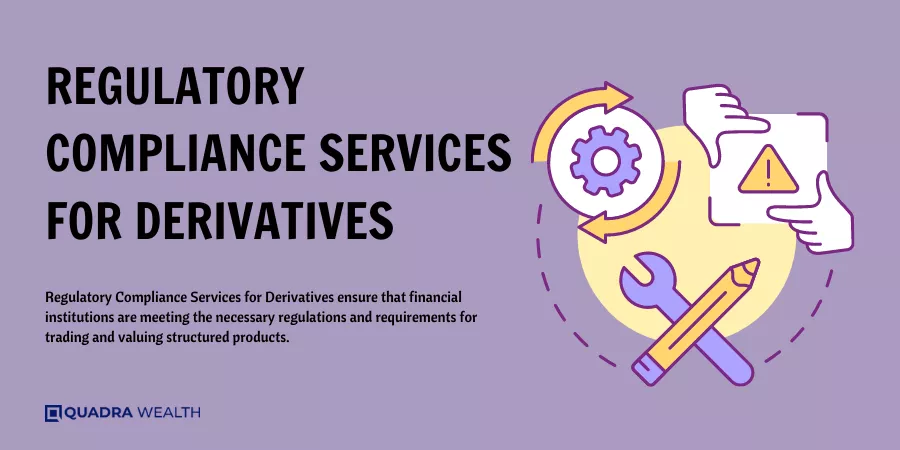Navigating the complexities of structured product valuation can often feel overwhelming. It’s a critical process that plays a significant role in risk management for financial institutions, affecting everything from asset managers to insurance companies.
This article simplifies the entire procedure and makes it understandable, detailing what you need to know about the key stakeholders involved, regulatory requirements, different approaches to valuation, and practical implementation.
Get ready to explore the world of structured note valuation demystified!
Key takeaways
●The valuation of structured products is a critical process for institutions that helps in managing risk and regulatory compliance.
●Key stakeholders in the structured products market include asset managers, banking institutions, insurance companies, and other financial organizations.
●There are two approaches to valuation: in-house valuation and external valuation, each with its own benefits and drawbacks.
●The valuation process involves collecting relevant data, identifying valuation models, inputting parameters, calculating market value, reviewing bid-ask spread, considering secondary market prices, reconciliation, and verification, and reviewing external factors.
Understanding Structured Products
Structured products are complex financial instruments that are created by bundling different types of underlying assets together. They often involve derivative component and can be tailored to meet specific investment goals or risk profiles.

Definition and Introduction
Structured products represent a type of investment that includes pre-packaged strategies based on derivatives. This financial instrument often issued by banks, is primarily used to enhance yields on regular deposits while offering potential principal protection against downside risk.
The key elements of structured products include an underlying asset, performance feature, and protective component. They cater to specific institutional investors’ needs not met by traditional investments like common stock, mutual funds, and bonds.
Various stakeholders such as asset managers, insurance companies, and banking institutions need accurate independent valuations for these complex Over Counter (OTC) Derivatives due to their importance in managing the risk and regulatory requirements.
The Issuing Wrappers
Issuing wrappers serves as packaging for structured products. They often take the form of notes, bonds, or other financial instruments that house complex OTC derivatives within them.
These wrappers are significant as they provide a layer of principal protection to retail investors by ensuring regulatory compliance and creating an easier path for these structured products to reach secondary market exposure.
Financial institutions such as banking and insurance companies utilize issuing wrappers in managing their risk process. It’s common practice for asset managers and insurers alike to actively use these wrapping techniques.
For instance, a zero-coupon bond (ZCB) might function as the wrapper for an option, warrant, or some other derivative inside it. As such, this ZCB would be dubbed a structured product because it consists of more than one underlying component – its intrinsic value plus the embedded derivative’s value.
Key Stakeholders in the Structured Products Market
The sell-side and the buy-side are two key stakeholders in the structured products market.

Sell Side
Asset managers, banking institutions, insurance companies, and other financial organizations comprise the sell side of the structured products market. Their primary role revolves around assessing underlying assets’ fair value critical for managing default risk processes.
This valuation must comply with several standards including IFRS, PRIIPS, UCITS, Solvency II, and more regulations such as EBA, AIFM, FRTB, and EMIR. Due to the advanced skills required in this process, some entities choose to outsource their valuations tasks to expert third-party evaluators.
These external parties offer fruitful insights into complex structured products owing to their refined expertise and comprehensive knowledge of reference asset evaluation methodologies.
The Buy Side
The buy side of the structured products market includes asset managers, banking institutions, insurance companies, and other institutions.
As key stakeholders, they rely on independent valuation to accurately estimate the fair value of an underlying asset and effectively manage risks.
Due to the high costs associated with IT infrastructure, data, and expertise, many companies outsource valuation to specialized third-party valuers.
This ensures regulatory compliance and allows these stakeholders to make informed decisions based on unbiased assessments of their investments. Thus regulatory bodies such as the Securities and Exchange Commission (SEC) and the Commodity Futures Trading Commission (CFTC) are intensifying their scrutiny of derivatives and structured product activities.
The challenge lies in gathering the right data consistently and without bias throughout the valuation process.
The Importance of Valuation for Structured Products
Valuation is of utmost importance for investment products due to regulatory requirements and the necessity for managing default risk.

Regulatory Requirements
Regulatory requirements play a crucial role in evaluating structured products. Market participants are now required to calculate indicators that reflect the current and future behavior of their structured products, as demanded by regulators.
These valuation processes must adhere to various regulatory standards including IFRS, PRIIPS, UCITS, Solvency II, EBA, AIFM, FRTB, and EMIR. Additionally, these regulations stipulate that financial assets be independently valued by a party without any interest in the transaction.
This ensures objectivity and transparency in the valuation process. However, complying with these regulatory requirements can be challenging for companies due to the need for IT infrastructure, data expertise, and specialized knowledge.
Necessity and Benefits
An independent valuation of structured products is an absolute necessity for asset managers, banking institutions, insurance companies, and other investments institution.
It allows them to accurately assess the fair value of their multiple assets, which is crucial for managing default risk. In addition to fulfilling regulatory requirements, such as IFRS standards, PRIIPS, UCITS, Solvency II, EBA, AIFM, FRTB, and EMIR; a comprehensive valuation also enables market participants to evaluate both current and future behavior patterns of their structured products.
By understanding the true and present value of the underlying securities they hold or intend to buy or sell in the market, honest sellers are better equipped while dishonest sellers can be easily identified.
Approaches to Valuation
There are two approaches to the valuation of structured products: in-house valuation and external valuation.

In-house vs Externally
When it comes to the valuation of structured products, there are typically two approaches: in-house valuation and external valuation. Each investment strategy has its benefits and drawbacks that firms should consider before making a decision.
In-house Valuation | External Valuation | |
1. Control | Firms have total control over the valuation process and can make adjustments as needed. | Control over the valuation process is limited, and adjustments may not be possible. |
2. Cost | Costs can be high, especially for small firms, as it involves hiring a dedicated team. | Often more cost-effective, especially for firms that don’t have the resources for a dedicated team. |
3. Specialized Knowledge | Requires specialized knowledge and training, which not all firms may have. | Third-party valuers bring specialized knowledge and experience to the job. |
4. Regulatory Compliance | Meeting regulatory requirements in-house can be challenging due to constant changes in regulations. | External valuers provide assurance of regulatory compliance, as this is their area of expertise. |
5. Bias | Potential for bias, as the valuation department may have interests in the valued asset. | Less potential for bias, as external valuers are independent and don’t have any interest in the transaction. |
Hence, the choice between in-house and external valuation of structured products depends on various factors including firm size, resource availability, regulatory complexity, and the need for independence. Some firms may even choose a hybrid approach, combining in-house and external resources, to balance control and expertise.
The Valuation Process
The valuation process for most structured products involves several key steps:
- Collecting Relevant Data: The first step in the valuation process is gathering all the necessary data, including market prices, interest rates, and other relevant information.
- Identifying Valuation Models: Depending on the type of structured product being valued, different models may be used, such as option pricing models or Monte Carlo simulations.
- Inputting Parameters: Once the appropriate valuation model is selected, specific parameters related to the structured product must be inputted. This includes factors such as notional sizes, payoff structures, and financial markets parameter.
- Calculating Market Value: Using the chosen valuation model and input parameters, the market value of the structured product is calculated. This represents an estimate of its worth based on current market conditions.
- Reviewing Bid-Ask Spread: In addition to calculating the market value, it’s important to consider the bid-ask spread. This refers to the difference between what buyers are willing to pay (bid) and what sellers are asking (ask) for a particular asset.
- Considering Secondary Market Prices: If there is an active secondary market for similarly structured products, their fair price can provide additional insight into valuing the asset in question.
- Reconciliation and Verification: After completing the initial valuation calculation, it’s essential to reconcile any discrepancies and verify that all inputs and calculations are accurate.
- Reviewing External Factors: Finally, external factors such as credit risk assessment and future market expectations may need to be considered in order to refine or validate the initial valuation results. The credit risk from the structured note issuance can be hedged using credit default swaps (CDS).
- Risk Management
- Regulatory Compliance
- Informed Decision-making
- Transparency
- Fair Pricing
- Default Risk Management
- Portfolio Optimization
- Mispriced Products
- Regulatory Non-compliance
- Uninformed Risk Assessment
- Lack of Transparency
- Misalignment with Objectives
- Difficulty in Hedging
- Market Distortions
- Investor Confidence Loss
Practical Valuation of Structured Products
In the practical valuation of structured products, support and reconciliation play a crucial role in ensuring accurate and reliable valuations. This involves utilizing comprehensive data sources, leveraging expertise in market pricing models, and conducting rigorous checks for consistency and accuracy.

Support and Reconciliation
- Support and reconciliation play a crucial role in understanding and resolving discrepancies in the valuation of structured products.
- The EMIR ISDA protocol and mandatory reconciliation of derivatives help in resolving any differences in valuation.
- Finalise offers a regulatory compliance service dedicated to derivatives, which covers various aspects of valuation and reporting.
- Reconciliation and dispute resolution are vital for promoting trust, transparency, and accuracy in the valuation process.
- Valuation results must be justified to auditors, regulators, and counterparties, with all assumptions and inputs clearly stated.
- The valuation process requires IT infrastructure, data expertise, and resources that can be costly for many companies.
Valuation in Practice
Valuation in practice involves the following:
- Gathering accurate and reliable data from various sources.
- Analyzing market parameters, such as interest rate and volatility models, to determine the value of the structured product.
- Taking into account factors like notional sizes, payoff structures, and credit ratings to assess risk-return profiles.
- Hedging against potential risks, such as correlation risk, credit risk, and foreign exchange exposure.
- Using proprietary methodologies or specialized data proxies for more accurate valuations.
- Collaborating with dedicated valuation teams or outsourcing to third-party valuers for expertise and efficiency.
- Ensuring compliance with regulatory requirements like IFRS standards and EMIR protocols.
- Maintaining a robust IT infrastructure for efficient calculation and management of valuation processes.
- Performing scenario analysis, stress tests, and P&L explainers to assess performance under different conditions.
- Collaborating with other stakeholders, such as traders, structures, and sales teams, to ensure alignment in valuation approaches.
Regulatory Compliance Services for Derivatives
Regulatory Compliance Services for Derivatives ensure that institutions are meeting the necessary regulations and requirements for trading and valuing structured products.

The Derivatives Academy
The Derivatives Academy is a leading provider of regulatory compliance services for derivatives, including the valuation of structured products. With their expertise and experience in the field, they offer dedicated services to assist companies in meeting regulatory requirements and ensuring accurate valuations.
Many companies find it challenging to maintain a dedicated valuation team due to cost constraints, which is why outsourcing to specialized third-party valuers like The Derivatives Academy has become a popular option.
They provide the necessary IT infrastructure, data, and expertise that may otherwise be prohibitive for many organizations.
As a trusted partner, The Derivatives Academy helps navigate the complexities of valuation in an ever-changing market landscape.
Dedicated Services for Derivatives
Companies that lack the resources to maintain an in-house valuation team often turn to specialized third-party valuers for dedicated services in derivatives. These experts offer a range of services, including accurate and independent valuation of complex OTC derivatives.
By outsourcing their valuation needs, companies can ensure compliance with regulatory standards such as IFRS, PRIIPS, UCITS, Solvency II, EBA, AIFM, FRTB, and EMIR.
This allows them to meet regulatory requirements without the need for extensive IT infrastructure or data expertise which can be costly for many businesses.
Conclusion
In conclusion, the valuation of structured products is essential for institutions to accurately assess risk and make informed decisions. Regulatory requirements make it necessary to calculate not just a price, but also indicators of future behavior.
By utilizing independent valuers and following industry standards, companies can ensure accurate and compliant valuations that contribute to their overall success in the competitive market.
FAQs
Structured products are typically valued using a combination of mathematical models, market data inputs, and assumptions about future market conditions. These valuations take into account the specific features and payout structures of each structured product.
The valuation of structured products is influenced by several factors, including interest rates, volatility in an underlying asset or indices, credit ratings of issuers, and prevailing market conditions. Changes in these factors can impact the value of the Structured product.
Yes, different types of structured products may require different valuation methodologies based on their complexity and underlying asset classes. For example, options-based structured products may be valued using Black-Scholes or other pricing models.
It is generally recommended to independently assess the value of a structured product rather than relying solely on the issuer’s stated value. This can involve consulting with financial professionals who specialize in valuing such instruments to ensure an accurate assessment and understanding of the potential risks involved.








